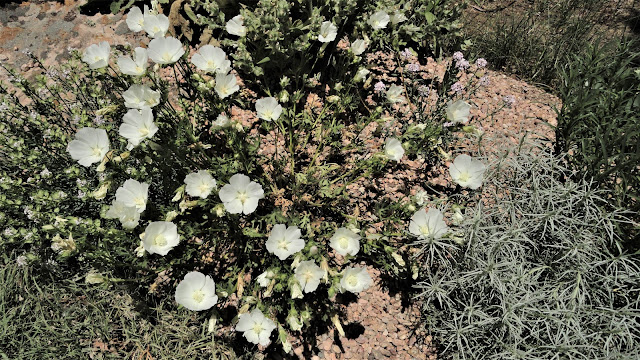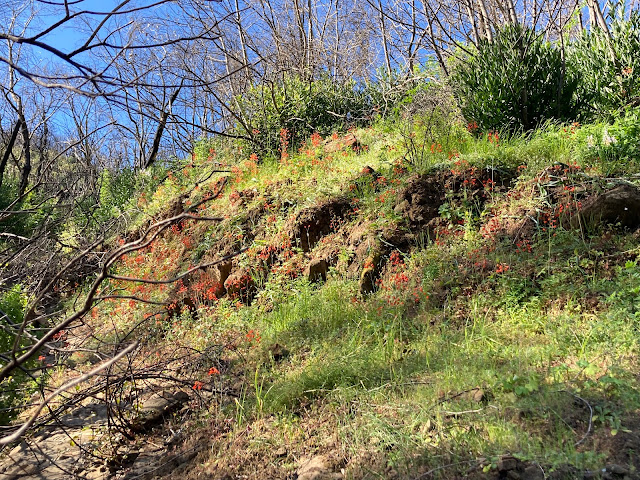 |
| Calceolaria arachnoidea |
I continue my saga of plants that have vanquished me: this is one I kill repeatedly---but it goes from strength to strength in the Steppe Garden at DBG. I am a little distressed they haven't propagated a few hundred of them and covered the whole damn slope with them between the massive cushions of Petunia and Azorella: that would drive me even crazier than I already am.
This picture was taken a few years ago: this year is was
much bigger. Harrumph! It's galling to know it would probably LOVE my new crevice garden--and of course they won't have any propagated for this spring's plant sale--that's the way the world works.
I gave grown no end of Calceolaria biflora, Calceolaria polyrhiza--you name it-- looking pretty much the same as this. And then there's old 'John Innes': they look splendid one--maybe two years--and then you you have to start all over again...which I do.
And then there's THIS patch at Betty Ford Alpine Garden: a yard or more across. They've grown for decades (looks like what I keyed out as
C. lanceolata click on the link and you'll see a picture I took of it in the wild over 20 years ago!): they have a greenhouse now--maybe I can beg some from THEM?
.JPG) |
| Callirhoe althaeoides |
Taken in my garden maybe twenty years ago: it looked so GOOD, so LONG LIVED. It wasn't. I have dismal luck with the whole genus except
C. bushii which loves my garden but is in the middle of a hideous patch of Johnson grass...I have two good friends who give me no end of husky, gallon sized
C. involucrata which my rabbits promptly devour: I cage the damn plants, and they still peter away. There is NO justice in the world. NONE!
And here's the same plant growing in the wilds of Kansas. I hope you noticed my plant is much bigger...
This was my champion patch of
C. involucrata var. tenuisecta at Denver Botanic Gardens: I have a sneaking suspicion SOMEone of my successors [not naming names here] rounded it up--it was taking over the Universe...I wish it would take over mine at home.
One of my colleagues planted
Calycanthus x 'Hartladge Wine' at the Botanic Gardens' house--where it's happy as a clam. And I bet they don't even KNOW who Hartladge is: I not only know, Richard and I are PALS! Practically blood brothers! But is his avatar willing to grow for me? NOOOOOOOOOOOOOOOOOOOOOOOOO....(best spoken as Belushi would---- with a bit of a whine and terrific modulations)
Just look at that flower...UGGH.
And now begins the saga of
Campanula--near the top of my favorite genera. They bloom mostly in summer, and I love those blues (however tinged with lavender)...but why is it they seem to be either ineradicable weeds or will-o-the-wisps?
 |
| Campanula alpestris (allionii) |
This stunner from the alps ramped through yards of a scree and threatened to take over Denver before departing suddenly.
 |
| Campanula cashmeriana |
This persisted for a number of years. Until it didn't.
I've grown
Campanula choruhensis for ages--and had it last quite a while: but this pink one came and went. Sniff.
Wbat can be easier to grow than
Campanula cochlearifolia, that also spreads like wildfire. It too got extinguished--here in a crevice garden at DBG.
It's big and gangly and persisted for a long time--but
Campanula sibirica decided to go home finally.
Its close cousin,
Campanula incurva, never goes away: it self sows gratifyingly. But
C. formanekiana does not. Enough said.
Campanula fragilis var. cavolinii is near the top of my topmost list. Unfortunately it too departed.
I once had
Campanula raineri fill a trough. That trough is now empty.
Few plants LOOK so long lived and tough as
Carduncellus pinnatus and its sibling (below). Appearances are deceiving!
 |
| Carduncellus rhaponticoides |
Another dear departed. I love this plant.
This
Castilleja scabrida was NOT photographed in Utah or canyonlands elsewhere--it grew contentedly in one of my troughs for nearly a decade. It is not there now.
I apologize: the LAST picture before the one above was taken in Utah. This far happier plant was in my trough!
You know you are a Bona Fide plant nerd when you miss the likes of Caulanthus crassicaulis. The flowers are pinched, and black--as they are for most species in the genus. What fun it would be to grow all 18 homely and homologous species! (And there are those who watch football on television).
Scanned from a photo from decades ago:
Centaurea drabifolia is still offered by certain Czech collectors...which reminds me, gotta finish my order to Mojmir.
Centaurea gymnocarpa isn't hardy for us, I'm sure. But what a delightful butterfly magnet in a pot!
There are those who love the raggedy flowers of thistles and their cousins. And there are those who have no taste whatsoever. Thistles and centaureas jostle near the top of my favorites list with
Campanula (and a few dozen other genera as well, I grant you!)
Centaurea ruthenica has incredibly thick, leathery leaves that are gorgeous in their own right and these cool yellow flowers. It DID last for a very long time at DBG. But is no more...to think I've only grown a dozen or maybe two
Centaurea in my life--and there are still a thousand or so to go!
 |
| Chaenorhinum villosum |
I believe this was growing on the Childrens' garden green roof section at Denver Botanic Gardens. I can tell you it is not growing for me.
 |
| Chamaerhodos mongolicus |
I only had one of these, but it DID persist for a very long time. I would like to have a lot more of them (and the bright pink forms a certain Russian keeps posting on Facebook). It has a tiny biennial congeneric cousin in South Park [the real place, not the TV show] that's quite common and utterly ignorable.
 |
| Chorispora macropoda |
This has the misfortune of being in the same genus as a pernicious weed in the West (and also cousin to a stunningly gorgeous and ungrowable alpine treasure from the Tian Shan). And it too is gone.
This chrysanthemum was collected in the Atlas Mountains--likely by my colleague Mike Kintgen--here thriving in our Childrens garden. It throve for me too...once.
I posted this image (or one like it) on a blog I
once wrote about my sad obsession with this genus. I have not given up on
Chrysosplenium quite yet...but they have given up on me. I have none at present in my garden.
We're only half way through the C's: with our winter stretching out interminably [with no trips to Mexico or the southern Hemisphere to leaven it] who knows? I may just get through the whole dang alphabet at this rate!

.JPG)






.JPG)

.jpg)



.JPG)











.jpg)
.JPG)


.jpg)






.JPG)
.JPG)

.JPG)
.JPG)

.JPG)





.JPG)





